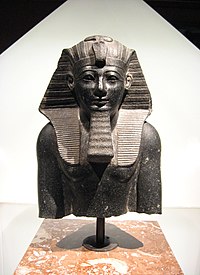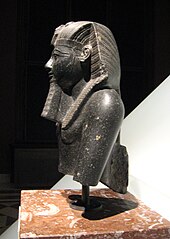Upper part of a statue of King Thutmose III. (KHM 70)
| Upper part of a statue of King Thutmose III. (KHM 70) | |
|---|---|

|
|
| material | Granodiorite |
| Dimensions | H. 46.5 cm; W. 30.6 cm; T. 20.3 cm; |
| origin | unknown, possibly from Thebes |
| time | New Kingdom , 18th Dynasty , between 1480 and 1425 BC Chr. |
| place | Vienna , Kunsthistorisches Museum , KHM 70 |
The top of a statue of King Thutmose III. (KHM 70) is in the Egyptian-Oriental Collection of the Kunsthistorisches Museum (KHM) in Vienna and represents the ancient Egyptian King ( Pharaoh ) Thutmose III. from the 18th Dynasty of the New Kingdom . The assignment is based on the similarity of the facial features with secured portraits of this king. There are also hieroglyphs with the beginning of the king's name on the rest of the back pillar , but these are not sufficient for a clear identification.
Thutmose III. was one of the most important rulers of Egypt. At first he was pushed back as the actual ruler by his stepmother and aunt Hatshepsut , but after their death, through military skill, led Egypt to a world empire whose influence extended from Sudan to the Euphrates .
Since only the upper part of the statue has survived, it is not possible to conclusively determine the posture of the original statue. The upper arms, which are swung slightly forward and the beginning of a slight bend on the left arm, may indicate that the statue originally kneeled and offered a spherical vessel as a sacrifice with each hand. Undoubtedly, the king wore the short ceremonial apron of the pharaohs below his bare torso. The royal regalia also included the Nemes headscarf , the rearing uraeus snake on the forehead and the artificial beard.
Helmut Satzinger comments on the effect of the work:
“This work is due to its idealization, the elegance of the representation, the excellent material processing, but above all the personality that is expressed in it, a prime example of Egyptian king sculpture. The sculpted plasticity of the face - a typical "Thutmosid face", as the portraits of the rulers of the early 18th dynasty obviously show due to the large family resemblances - is enhanced by the plastic make-up strokes on the eyes and brows, by the broad, detailed ceremonial beard and by the canonical headscarf, den nemes, raised. "
Thus the sculpture of the early New Kingdom does not follow the expressive, realistic design of the Middle Kingdom , such as the head of a Sphinx Sesostris III. (12th Dynasty) shows, but rather on their forerunners, which are of a more binding nature: The royal sculpture in particular is characterized by the expression of an inner calm, almost a serene serenity, appropriate to the dignity of a ruler who embodies God on earth.
literature
- Helmut Satzinger : Egyptian Art in Vienna. Kunsthistorisches Museum, Vienna 1980, ISBN 3-900325-03-0 .
- Helmut Satzinger, Jürgen Liepe: The Art History Museum in Vienna. The Egyptian-Oriental Collection (= Ancient World. Special 1994; Zabern's illustrated books on archeology. Vol. 14). von Zabern, Mainz 1994, ISBN 978-3-8053-1600-2 .
Web links
- Upper part of a statue of King Thutmose III. in the object database of the Kunsthistorisches Museum Vienna
- Entry and description on The Global Egyptian Museum
Individual evidence
- ^ H. Satzinger: Egyptian Art in Vienna. Vienna 1980, p. 27.
- ^ Thomas Schneider: Lexicon of the Pharaohs. Albatros, Düsseldorf 2002, ISBN 3-491-96053-3 , p. 291ff.
- ^ A b H. Satzinger, J. Liepe: The Art History Museum in Vienna. The Egyptian-Oriental Collection. Mainz 1994, p. 20.
- ^ H. Satzinger: Egyptian Art in Vienna. Vienna 1980, p. 27.
